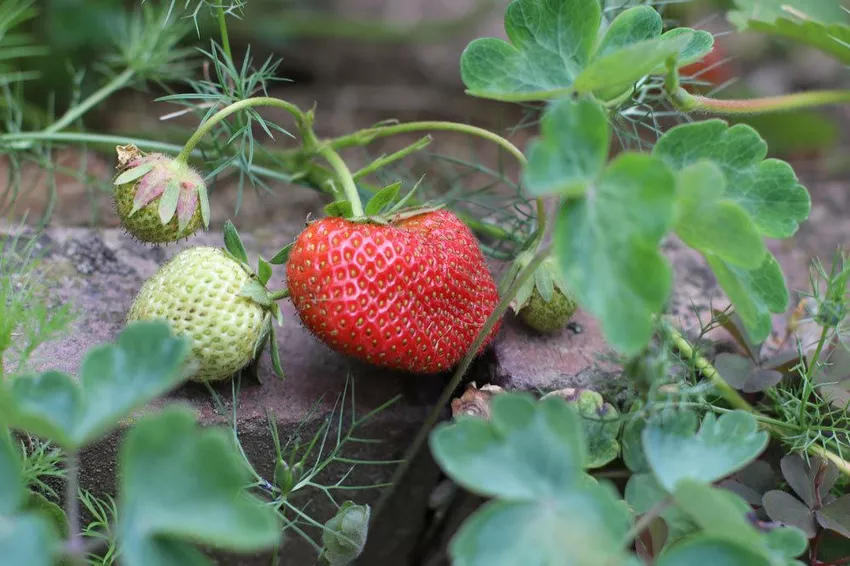
The mixed culture of strawberries makes sense for various reasons - but this only applies if the right plants are chosen as neighbors. Because then, for example, the growth of the strawberries, also known as Fragaria, can be promoted or pests and even diseases can be kept away from them. An unfavorable choice, on the other hand, can limit growth. In the following, we reveal which planting neighbors make sense and which, on the contrary, can harm the strawberry plants.
Mixed culture of strawberries
Mixed cultures are preferred in ecological horticulture because they correspond to nature's model. Various plants are planted next to each other. However, the reason for this is not only that the natural spread of plants should be as close as possible. Combined planting has other advantages as well. These include, among others:
- Promotion of growth or revitalizing effect
- Keeping away from pests
- disease prevention
- Protection during hibernation
However, care must be taken to ensure that the appropriate plants are placed side by side. Otherwise there could be negative consequences. These include, among others:
- Competition for water and nutrients
- excessive shading of smaller plants
- increased attraction of pests
- weakening of growth
- increased susceptibility to diseases
- Matching plant neighbors

Various plants are suitable for mixed cultivation with strawberries. Below:
- borage has a beneficial effect on the setting of flowers in strawberry plants and can also have a positive effect on fertilization
- dill, chamomile and lemon balm have a revitalizing effect on the Fragaria and can sometimes keep pests away
- Lamb's lettuce and spinach get along wonderfully with strawberry plants and protect them from snow during the winter
- garlic, leek and onions have a deterrent effect on snails and can thus keep the pests away from the strawberry
- marigolds have a kind of cleaning effect on the soil and scare away potential pests such as wireworms and nematodes
- chives and shallots are also leeks and repel fungal spores, they can also prevent the outbreak of diseases
- tagetes are also known as marigolds and, like some of the leek plants mentioned, keep snails away
In addition to the various effects, the plants mentioned also have the advantage that they do not cast too much shade with appropriate care and sufficient distance.
notice: You can also combine more than two different types of plants. In turn, it is important that the selected plants are "green" with one another, i.e. have a positive influence on one another or at least do not hinder one another.
Unfavorable plant neighbors
In the mixed culture with strawberries, it is crucial that you do not choose unfavorable planting neighbors. Of course, the following list also helps to set the right distance between the plants if they are to be planted in the same garden. The unfavorable plant neighbors for the Fragaria are, among others:
- gladioli
- grasses
- potatoes
- broad beans
- rose family
- all types of cabbage
- tulips
These plants either cast too much shade, draw too much water and nutrients from the soil, or give off oils that can be harmful to the strawberry plants. Therefore, a distance of at least three meters should be maintained between the plants.
Plant strawberries in mixed culture
You should pay attention to a few factors when planting so that the right plant neighbors can also develop well in the mixed culture. These include:
1. Keep your distance
Plants need enough space. Not only for the growth of leaves and roots, but also to get enough water and nutrients. Different plant species require different spacing. When planting, you should therefore consider the requirements of each individual plant.
2. Alternate planting
In a bed, it is advisable to plant the plants "in a gap". This means that you put a strawberry and another plant. This allows you to optimally use the respective effect of the plant.
3. Shade in moderation
Larger or sprawling plants also cast a corresponding amount of shade. However, it is already too dark for the strawberries in the stronger penumbra. Therefore, when planting, you should either take into account that taller plants do not cast shadows directly on the strawberries, or they must be trimmed accordingly. For this reason, it makes little sense to place larger flowering plants or climbing plants next to the strawberries.
4. Consider claims
Not only the distance, but also water, fertilizer and care as well as winter storage must be taken into account. It can also make sense to only place individual plants in pots or tubs between the strawberry plants. This makes it easier to separate, care for and hibernate plants that get along well but have major differences in care.

